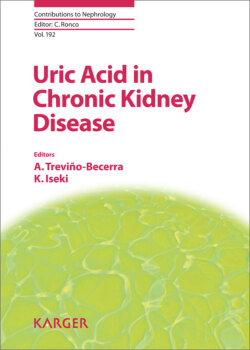Читать книгу Uric Acid in Chronic Kidney Disease - Группа авторов - Страница 25
На сайте Литреса книга снята с продажи.
Hyperuricemia and Hypertension, Implications in Renal Damage
ОглавлениеThe association between hyperuricemia and hypertension is accepted and supported by the following observations:
• Hyperuricemia prevalence of approximately 20–40% in untreated hypertensive patients and 50–70% in hypertensive patients treated or with renal impairment.
• Gout prevalence of 2–12% in hypertensive patients.
• Prevalence of hypertension of 25–50% in patients with gout.
• Increasing prevalence of hyperuricemia with increasing blood pressure in the general population.
• Increasing risk for development of hypertension with increasing baseline serum urate levels [16].
Despite these assertions, the conflicting results of different studies avoid establishing a cause effect. Grahame and Scott [17] documented that the high prevalence of hypertension in patients with gout had a strong association with obesity more than with the duration of gout. In the Ischemic Heart Disease Study of Israel, it was documented that only 1% of the variation in blood pressure could be explained by serum urate [18]. In other studies, the association of elevated serum levels of uric acid with the future development of hypertension has been documented [19, 20].
From animal models, Feig [21] has suggested a 2-phase mechanism through which hyperuricemia leads to the development of hypertension. Initially, uric acid induces vasoconstriction by the activation of the renin-angiotensin system and reduction of circulating nitric oxide, which can be reversed by lowering uric acid. In the second phase, uric acid mediated arteriolosclerosis. Uric acid uptake into vascular smooth muscle cells causes the activation and elaboration of production of growth factor and monocyte chemoattractant protein-1. It causes cellular proliferation and secondary arteriolosclerosis that impair pressure natriuresis, causing sodium-sensitive hypertension [22]. This observation has been previously described, finding that uric acid stimulates the proliferation of vascular smooth muscle cells, precisely because of the expression of this cytokine. Among the alterations in the renal structure that have been described are glomerular hypertrophy, glomerular hypertension, afferent arteriolar sclerosis, tubulointerstitial injury along with monocyte infiltration, and the development of mild vascular disease involving the preglomerular arterioles [23, 24].
